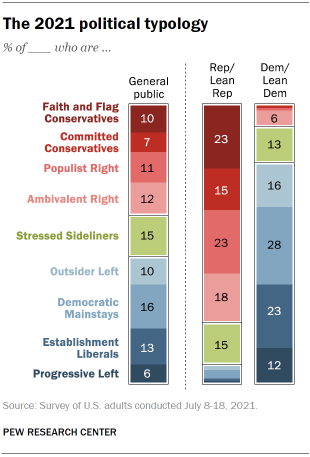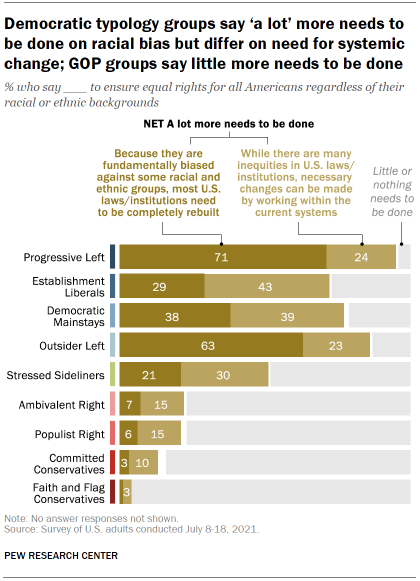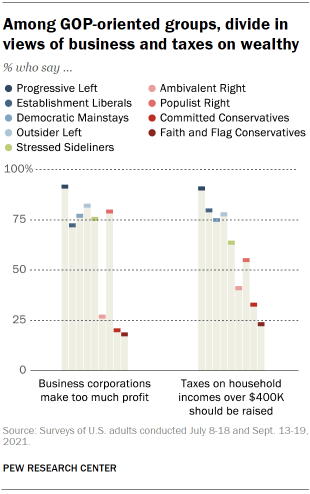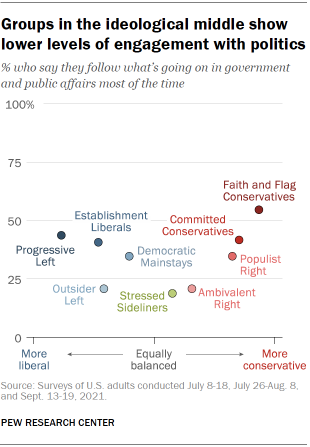Hi Its Me Again the Opposite Politial Party
Fifty-fifty in a polarized era, deep divisions in both partisan coalitions
Pew Research Heart conducted this study to learn more than near the complexity of the current political environment. While partisanship remains the dominant gene in politics, we sought to identify the fissures within both partisan coalitions. We did this by creating a political typology, which classifies the public into nine singled-out groups based on their political values and attitudes. To learn more about the political typology, including its history and the statistical methods used to create the typology, run across "Behind Pew Research Center'south 2021 Political Typology."
The written report is primarily based on a survey of 10,221 adults conducted on Pew Research Center's nationally representative American Trends Panel (ATP) from July 8-18, 2021; it also draws from several additional interviews with these respondents conducted since January 2020 (for more on the surveys used for analysis, encounter Appendix B and the detailed tables.
Everyone who took part in this survey is a member of the ATP, an online survey panel that is recruited through national, random sampling of residential addresses. This fashion nearly all U.South. adults take a chance of selection. The survey is weighted to be representative of the U.S. developed population by gender, race, ethnicity, partisan affiliation, education and other categories. Read more than about the ATP'south methodology.
Hither are the questions used in the main typology survey, along with responses, and the survey methodology.
Partisan polarization remains the dominant, seemingly unalterable condition of American politics. Republicans and Democrats concord on very piffling – and when they do, it frequently is in the shared conventionalities that they have little in common.

Still the gulf that separates Republicans and Democrats sometimes obscures the divisions and diversity of views that exist inside both partisan coalitions – and the fact that many Americans do not fit easily into either one.
Republicans are divided on some principles long associated with the GOP: an affinity for businesses and corporations, support for depression taxes and opposition to ballgame. Democrats face substantial internal differences every bit well – some that are long-standing, such as on the importance of organized religion in society, others more contempo. For instance, while Democrats widely share the goal of combating racial inequality in the U.s., they differ on whether systemic change is required to accomplish that goal.
These intraparty disagreements present multiple challenges for both parties: They complicate the already difficult task of governing in a divided nation. In addition, to succeed politically, the parties must maintain the loyalty of highly politically engaged, more than ideological voters, while also attracting support amidst less engaged voters – many of them younger – with weaker partisan ties.
Pew Research Center's new political typology provides a road map to today's fractured political landscape. It segments the public into nine distinct groups, based on an analysis of their attitudes and values. The study is primarily based on a survey of 10,221 adults conducted July viii-18, 2021; it also draws from several additional interviews with these respondents conducted since January 2020.
This is the Center's eighth political typology since 1987, but it differs from earlier such studies in several important ways. Information technology is the get-go typology conducted on Pew Research Center'south nationally representative American Trends Console, which provides the benefit of a large sample size and the ability to include a wealth of other political data for the analysis, including the Eye's validated voter study.
The four Democratic-oriented typology groups highlight the political party'south racial and ethnic multifariousness, as well as the unwieldy nature of the current Autonomous coalition. ( For complete descriptions of all nine typology groups see Chapters iii-11; for profiles of the Democratic and Republican coalitions see Chapters 1 and 2 of this report.)
They include two very different groups of liberal Democrats: Progressive Left and Establishment Liberals. Progressive Left, the only majority White, non-Hispanic group of Democrats, have very liberal views on virtually every issue and support far-reaching changes to accost racial injustice and expand the social safety net. Establishment Liberals, while just as liberal in many ways as Progressive Left, are far less persuaded of the need for sweeping modify.
Two other Democratic-aligned groups could not be more different from each other, both demographically and in their relationship to the party. Autonomous Mainstays, the largest Democratic-oriented group, every bit well as the oldest on boilerplate, are unshakeable Democratic loyalists and accept a moderate tilt on some issues. Outsider Left, the youngest typology group, voted overwhelmingly for Joe Biden a year ago and are very liberal in most of their views, but they are deeply frustrated with the political system – including the Democratic Party and its leaders.
The four Republican-oriented groups include 3 groups of conservatives: Organized religion and Flag Conservatives are intensely conservative in all realms; they are far more probable than all other typology groups to say government policies should support religious values and that compromise in politics is only "selling out on what you believe in." Committed Conservatives too limited conservative views across the lath, just with a somewhat softer edge, particularly on issues of immigration and America's identify in the earth. Populist Right, who accept less formal education than most other typology groups and are among the nigh probable to alive in rural areas, are highly critical of both immigrants and major U.S. corporations.
Ambivalent Correct, the youngest and to the lowest degree conservative GOP-aligned grouping, hold conservative views most the size of government, the economical organization and issues of race and gender. Just they are the simply group on the political right in which majorities favor legal ballgame and say marijuana should be legal for recreational and medical use. They are also distinct in their views most Donald Trump – while a majority voted for him in 2020, most say they would prefer he non go on to be a major political figure.
The only typology group without a clear partisan orientation – Stressed Sideliners – too is the group with the everyman level of political engagement. Stressed Sideliners, who brand up xv% of the public but constituted merely ten% of voters in 2020, have a mix of conservative and liberal views but are largely defined by their minimal involvement in politics.
Here are the primary findings from the new political typology:

Racial injustice remains a dividing line in U.S. politics. Perhaps no issue is more divisive than racial injustice in the U.S. Among the four Republican-oriented typology groups, no more than about a quarter say a lot more needs to exist done to ensure equal rights for all Americans regardless of their racial or ethnic background; by comparing, no fewer than about three-quarters of any Democratic group say a lot more needs to be done to accomplish this goal. Notwithstanding, Democrats differ over whether the changes to ensure equal rights for all can be achieved by working within the current arrangement, or whether about laws and institutions need to be completely rebuilt. Progressive Left and Outsider Left are far more likely than the two other Autonomous groups to say systemic modify is needed to combat racial bias.
Democrats adopt bigger authorities – but how big? There are much bigger divides between parties than within them on opinions nigh the size of regime. Democratic-aligned groups overwhelmingly prefer a bigger government providing more services; GOP groups, by like margins, favor smaller authorities. But when asked if authorities services should be greatly expanded from current levels, Democrats are divided: A articulate bulk of Progressive Left (63%) favor greatly expanding regime services, compared with nigh a third in other Democratic-oriented groups.

Economical policy – including taxes – divides the GOP. As noted, Populist Right diverge sharply from traditional GOP positions with their very negative views of corporations; just 17% say most corporations brand a fair turn a profit, which places this conservative group much closer to Democratic groups than to their Republican counterparts. And a majority of Populist Right (56%) favor raising taxes on household incomes to a higher place $400,000, as do 42% of Ambivalent Right (and substantial majorities in all Democratic-aligned groups).
Republicans' complicated views of Trump. The Republican-oriented typology groups each supported Trump past wide margins in 2020. Yet the survey shows substantial differences among GOP groups over Trump's time to come political part. In two of the 4 groups – Faith and Flag Conservatives and Populist Right – majorities want Trump to remain a major political figure and run for president again in 2024. And only amid Populist Right does a clear plurality view Trump every bit the best president of the by forty years. Among other Republican-aligned groups, more either view Ronald Reagan equally the all-time recent president (Committed Conservatives, Ambivalent Right), or are divided between Reagan and Trump (Faith and Flag Conservatives).
Stark differences among typology groups on U.Southward. global standing. When asked whether the U.S. is superior to all other countries, it is amongst the greatest countries, or there are other countries that are better, there is relative agreement across six of nine typology groups: Well-nigh half or more in this very ideologically mixed set of groups – including Institution Liberals and Populist Right – say the U.S. is among the greatest countries in the world. Religion and Flag Conservatives are the merely group in which a majority (69%) says the U.S. stands in a higher place all other countries. Conversely, Progressive Left (75%) and Outsider Left (63%) are the only typology groups in which majorities say in that location are other countries better than the U.S.

Is there a 'middle' in politics today? Surveys by Pew Research Center and other national polling organizations have found broad support, in principle, for a third major political party. Yet the typology study finds that the three groups with the largest shares of self-identified independents (near of whom lean toward a political party) – Stressed Sideliners, Outsider Left and Ambivalent Right – take very little in common politically. Stressed Sideliners concord mixed views; Ambivalent Correct are conservative on many economic bug, while moderate on some social problems; and Outsider Left are very liberal on virtually bug, particularly on race and the social prophylactic cyberspace. What these groups do have in common is relatively low involvement in politics: They had the everyman rates of voting in the 2020 presidential election and are less likely than other groups to follow regime and public affairs well-nigh of the fourth dimension.
Source: https://www.pewresearch.org/politics/2021/11/09/beyond-red-vs-blue-the-political-typology-2/
0 Response to "Hi Its Me Again the Opposite Politial Party"
Post a Comment